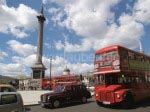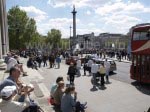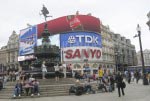|
|
Parks and Places of London
Many parks, streets and places of London are world famous, at least by their names. Either from movies, songs or literature, everybody apparently heard of Trafalgar Square, Hyde Park or Piccadilly Circus. The more interesting and exciting it is to experience live these places by standing on one of these places or parks. Those who still not noticed the life of London should not hesitate to do a trip to the British metropolis, as it is also possible to have some relaxing times in the parks so that one feels released from the hectic of the big city life. Trafalgar SquareLondon is the opposite of a tranquil and sleepy city, but at the Trafalgar Square, life seems to be double as wild. The place is considered to be the centre of London. 
The plaza was named after the English ocean heroe Admiral Horatio Nelson, who won against the French-Spanish fleet in the battle of Cap Trafalgar in the year 1805 but also lost his life there. The Nelson Column also reminds on him, a monument with a 56 m heighted column on which the 5 m heighted still image of Admiral thrones; Arranges in the centre of the plaza from 1840 to 1843, the column outperforms the Trafalgar Square so that it is a good help of orientation. 
The other monuments of the plaza are less distinctive, beside the dominant Nelson Column they often go a little under. They are dedicated to Henry Havelock, the Conqueror of the Indish Lucknow, the King Georges IV. and Charles I. 
In total, the plaza with its surrounding buildings is considered as one of the most beautiful of London, if not the most beautiful one. The neo-classical construction of the National Gallery at the northern side is very distinctive with the fountain at the front and the lion sculpture. The church St. Martin-in-the-Fields is one of the most famous of London. At the south-west corner of the plaza there is the Admirality Arch, an interesting portal archway at the Old Admiralty through which one gets to The Mall, the gorgeous street to the Buckingham Palace. Also worth to mention is the Canada House and the South Africa House. Trafalgar Square is already impressive during the day, but when we looked in the evening at the illuminated plaza, we were even more impressed by this view. The best way to get to Trafalgar Square is by subway up to the station Charing Cross or with one of the bus lines that stop at the proximity of the plaza. The plaza is also a good starting point for a walk through some of the gorgeous streets of London, as from this plaza, the famous streets as The Strand, Charing Cross Road, Whitehall, Haymarket and the already mentioned The Mall branch off. Leicester SquareThis plaza also belongs to the world famous ones. It is in the immediate vicinity of the Trafalgar Square and the National Gallery. The plaza and the street belong to the most vivid ones of London, but the are also coffee bars there with outdoor seats in which one can have a break. 
In the plaza itself there is a small green oasis in the centre with some benches, flower beds and grass. Several monuments that stand on the Leicester Square are specially noticeable. The most eye-catching one is the monument with the statue of the poet William Shakespeare that forms the centre of a small complex. At first sight, the statue of Charlie Chaplin is recognizable to everybody, the artist who could brilliantly represent humor and tradegy at the same time; Everything is completed by the monuments for William Hogarth, John Hunter and Isaac Newton. 

The monument of Chaplin does not stand at this plaza for nothing, as there, there are numerous big cinemas in which many times some premieres take place. One is also reminded on Hollywood by some other sightseeings. All around the plaza there are the handprints of numerous movie stars embedded. By the way, the name of the plaza is related to the Duke of Leicester, who had there his house nd some fields. The plaza is straight connected with the subway station Leicester Square. Piccadilly CircusPiccadilly Circus, a strange name to german ears, is located in the district of London Soho. Piccadilly, the term goes back to a successful taylor who designed a fashionable ruff in the 18th century, the picadil. His house that was located in the proximity of the present plaza, was bowdlerized by the vernacular to Piccadilly House and finally, the later plaza was named like it. 

The term circus comes from latin and means a circled public surface. Thus, some plazas of London got their names with the additional word "circus", also if they finally were not circled. Today, Piccadilly Circus is one of the most vivid plazas of the English metropolis. There, some of the most significant business streets of London get together, Piccadilly, Haymarket, Regent Street and Shaftesbury Avenue. 
The visual focus of the plaza is the monument of the Eros statue. Actually, it was supposed to represent an angel of christian charity, but then it finally resulted to be Eros, thus also a figure related to love. This statue is not popular among the London people maybe because it holds an arch in its hand but the arrow is already misplayed. How knows to where...? The fountain is a popular meeting point, its stairs are belegued by people at any time of the day, priorly by tourists. Another visual focus are the huge advertisement boards at the corner house of the Shaftesbury Avenue, that are, specially in the evenings as luminous advertising, specially effectful. At the Piccadilly Circus specially the London Pavilion and the Criterion Theatre are eye-catching buildings. The London Pavilion was built in the year 1859 that served as music hall and was renewed in the year 1886. Today it is a shopping centre. One can also wonderfuly shop in the surrounding streets. The most convenient way to get to this plaza is by subway up to the station Piccadilly or with one of the bus lines that circle there. Hyde ParkThose who look for a tranquil place in the vivid city of London will find it in one of the parks. The first address is the Hyde Park that merges nearly seamlessly into the Kensington Gardens. By this way, the apparently biggest park landscape was originated in the centre of the British capital. The Hyde Park is priorly world famous due to the Speaker's Corner, that corner where everyone can boundlessly express his opinion. By being a little lucky, still today it is possible to experience a speaker, who is standing on a podest or chair brought by himself or simply amidst a crowd expressing his opinion in public, no matter if it is more or less meanful. 

At this corner also Marble Arch is standing, a massive archway that actually was supposed to be the main portal to the Buckingham Palace. Someone threw a spanner in the works and the arch became much too narow for the Royal State Carriage, thus it found its place there. It was designed in the year 1828 by John Nash, who used the Roman Constantine Arch as model. The main entrance to the park is located at the Hyde Park Corner, where there is also the Wellington Museum. Since the year 1952, the arts collection of the Duke of Wellington is exhibited there. At a place in front of the museum there is the Wellington Arch, a triumphal arch that reminds on the victory of Wellingtons against Napoleon at Waterloo. It was originated in the year 1828, but the quadriga on its roof was not added until the year 1912. 
Right behind the entrance of the park the Achilles-Statue is visible that actually does not show the Greek heroe but is a replication of the Quirinal of Rome . This statue caused a public scandal during its inauguration in the year 1822, as it was the first representation of a naked man in Britain. The whole Hyde Park's surface is of approximately 1,4 km², together with the Kensington Gardens it forms a surface of approximately 2,5 km². The Serpentine, a large artificial lake is located quite centrally that also approximately marks the limit between the Hyde Park and the Kensington Gardens. Beside some large grass surfaces, patches of forest, garden- and water complexes, there are some playgrounds for children and it is also possible to do some boat trips in the Serpentine. Each summer, some concerts also take place in the park. Those who are in the mornings around 10.30 a.m. in the Hyde Park can watch the Household Cavalry that crosses the park from its quarter, the Hyde Park Barracks, to the Buckingham Palace. The Hyde Park was originated, by the way, from former hunting area of Henry VIII., that in the 17th century became the first public park of London. Even if it is a public park, it is closed from 00.00 a.m. to 5.00 a.m. But this should not be a problem, as there will be hardly tourists on the way at this time - at least not in the Hyde Park. Regent's ParkA walk in the Regent's Park can be easily combined with a visit to the Sherlock Holmes Museum and Madame Tussaud's. From both sightseeings, it only takes a few minutes walk to the park. With approximately 200 hectares, the park is surrounded by a ring, a car road. The inner ring surrounds Queen Mary's Gardens, a very noticeable garden complex with numerous rosebeds. Despite of these ringroads and the connection between both, the Regent's Park is purely a pedestrian area. 

The park mainly consists on extended meadows in which there is a large lake that is populated by numerous water birds. There, people can rent some rowboats and pedal boats can be rent in order to have a trip across the lake. For further leisure activities, the sports courts and playgrounds for children are available. A further attraction of London is located in the northern part of the park, the zoological garden, a zoo with a long tradition. It was opened in the year 1828 as an animal collection for scientifical study purposes and since the year 1847, it is accessible as a zoological garden to the public. The entrance fee of 15,40 pounds and 11,90 pounds for children is not half bad, but the visitors who have a London passport can get there for free. At the northern border of the Regent's Park there is the Regent's Canal on which one can have a boat trip. The London Canal Museum is also interesting, it is opened from Tuesdays to Sundays from 10.00 a.m. up to 04.30 p.m. The present Regent's Park also once belonged to Henry VIII., who bought the complex under the name of Marylebone Park. Later on, it was let for rent to the Dukes of Portland and then, in the first half of the 19th century, put at the disposal to the public as the Regent's Park. 
Author: Michael Nitzschke, Copyright: Patrick Wagner, www.tourist-guide.biz |
||